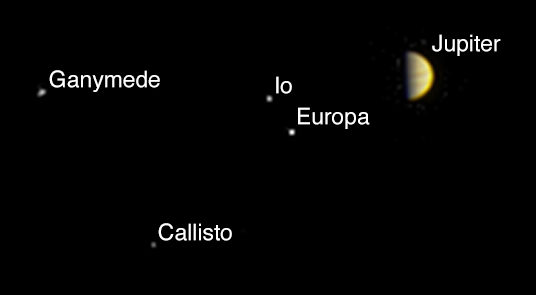 Astronomy
Astronomy
Sat Jan 09, 2016 2:12 am
 Practical Astronomy |
Practical Astronomy |
Fri Jan 22, 2016 12:07 pm
* about Practical Astronomy
We prefer the term "Practical" Astronomy , instead of
"amateur" astronomy , (You can learn everything by
yourself & I am completely Self Taught - "Self Learning"
can have the meaning of a personal , voluntary ,
self-motivated ,asocial and ongoing pursuit of knowledge
of the best kind But "amateur" means usually "inexperienced"
& "unskillful". Secondly amātor is the Latin for lover.
Lets be Sirius here .. (α Canis Majoris)
You don't have to "love" anything.
"Love is for amateurs")
We prefer the term "Practical" Astronomy , instead of
"amateur" astronomy , (You can learn everything by
yourself & I am completely Self Taught - "Self Learning"
can have the meaning of a personal , voluntary ,
self-motivated ,asocial and ongoing pursuit of knowledge
of the best kind But "amateur" means usually "inexperienced"
& "unskillful". Secondly amātor is the Latin for lover.
Lets be Sirius here .. (α Canis Majoris)
You don't have to "love" anything.
"Love is for amateurs")
 Re: Astronomy
Re: Astronomy
Fri Jan 22, 2016 2:41 pm
http://iopscience.iop.org/article/10.3847/0004-6256/151/2/22

EVIDENCE FOR A DISTANT GIANT PLANET IN THE SOLAR SYSTEM
Konstantin Batygin and Michael E. Brown
 Article PDF
Article PDF
http://www.caltech.edu/news/caltech-researchers-find-evidence-real-ninth-planet-49523

EVIDENCE FOR A DISTANT GIANT PLANET IN THE SOLAR SYSTEM
Konstantin Batygin and Michael E. Brown
 Article PDF
Article PDFhttp://www.caltech.edu/news/caltech-researchers-find-evidence-real-ninth-planet-49523
 Manhattan GandhiLeveL V
Manhattan GandhiLeveL V
- Posts : 565
Join date : 2016-01-09
Age : 47
Location : R'Lyeh
 Astronomy Links
Astronomy Links
Fri Mar 18, 2016 2:25 am

Tonight's Sky [hubblesite.org]

Red Planet Report
--------------------------------
http://www.astronomy.com/
 Manhattan GandhiLeveL V
Manhattan GandhiLeveL V
- Posts : 565
Join date : 2016-01-09
Age : 47
Location : R'Lyeh
 JPLJuno Approach to Jupiter
JPLJuno Approach to Jupiter
Wed Jul 06, 2016 10:13 am
 Manhattan GandhiLeveL V
Manhattan GandhiLeveL V
- Posts : 565
Join date : 2016-01-09
Age : 47
Location : R'Lyeh
 KIC 8462852
KIC 8462852
Sat Aug 06, 2016 6:00 am
KIC 8462852 FADED THROUGHOUT THE KEPLER MISSION
 Subject headings: stars: individual (KIC 8462852), stars: variables: general, circumstellar matter,
Subject headings: stars: individual (KIC 8462852), stars: variables: general, circumstellar matter,
techniques: photometric, methods: data analysis.
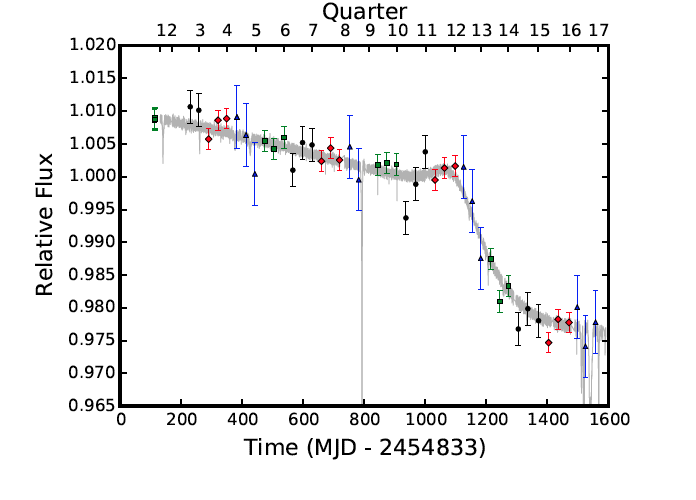
Photometry of KIC8462852 as measured by Kepler data.
ABSTRACT KIC 8462852 is a superficially ordinary main sequence F star for which Kepler detected an unusual series of brief dimming events.
We obtain accurate relative photometry of KIC 8462852 from the Kepler full frame images, finding that the brightness of KIC 8462852 monotonically
decreased over the four years it was observed by Kepler. Over the first ∼ 1000 days, KIC 8462852 faded approximately linearly at a rate of 0.341 ±
0.041% yr−1 , for a total decline of 0.9%. KIC 8462852 then dimmed much more rapidly in the next ∼ 200 days, with its flux dropping by more than
2%. For the final ∼ 200 days of Kepler photometry the magnitude remained approximately constant, although the data are also consistent with the
decline rate measured for the first 2.7 yr. Of a sample of 193 nearby comparison stars and 355 stars with similar stellar parameters, 0.6% change
brightness at a rate as fast as 0.341% yr−1 , and none exhibit either the rapid decline by > 2% or the cumulative fading by 3% of KIC 8462852. We
examine whether the rapid decline could be caused by a cloud of transiting circumstellar material, finding while such a cloud could evade detection
in sub-mm observations, the transit ingress and duration cannot be explained by a simple cloud model. Moreover, this model cannot account for the
observed longer-term dimming.No known or proposed stellar phenomena can fully explain all aspects of the observed light curve.
 Subject headings: stars: individual (KIC 8462852), stars: variables: general, circumstellar matter,
Subject headings: stars: individual (KIC 8462852), stars: variables: general, circumstellar matter,techniques: photometric, methods: data analysis.

Photometry of KIC8462852 as measured by Kepler data.
ABSTRACT KIC 8462852 is a superficially ordinary main sequence F star for which Kepler detected an unusual series of brief dimming events.
We obtain accurate relative photometry of KIC 8462852 from the Kepler full frame images, finding that the brightness of KIC 8462852 monotonically
decreased over the four years it was observed by Kepler. Over the first ∼ 1000 days, KIC 8462852 faded approximately linearly at a rate of 0.341 ±
0.041% yr−1 , for a total decline of 0.9%. KIC 8462852 then dimmed much more rapidly in the next ∼ 200 days, with its flux dropping by more than
2%. For the final ∼ 200 days of Kepler photometry the magnitude remained approximately constant, although the data are also consistent with the
decline rate measured for the first 2.7 yr. Of a sample of 193 nearby comparison stars and 355 stars with similar stellar parameters, 0.6% change
brightness at a rate as fast as 0.341% yr−1 , and none exhibit either the rapid decline by > 2% or the cumulative fading by 3% of KIC 8462852. We
examine whether the rapid decline could be caused by a cloud of transiting circumstellar material, finding while such a cloud could evade detection
in sub-mm observations, the transit ingress and duration cannot be explained by a simple cloud model. Moreover, this model cannot account for the
observed longer-term dimming.No known or proposed stellar phenomena can fully explain all aspects of the observed light curve.
 Manhattan GandhiLeveL V
Manhattan GandhiLeveL V
- Posts : 565
Join date : 2016-01-09
Age : 47
Location : R'Lyeh
 Pluto's Sputnik Planum
Pluto's Sputnik Planum
Tue Dec 06, 2016 7:20 pm
Pluto's Sputnik Planum
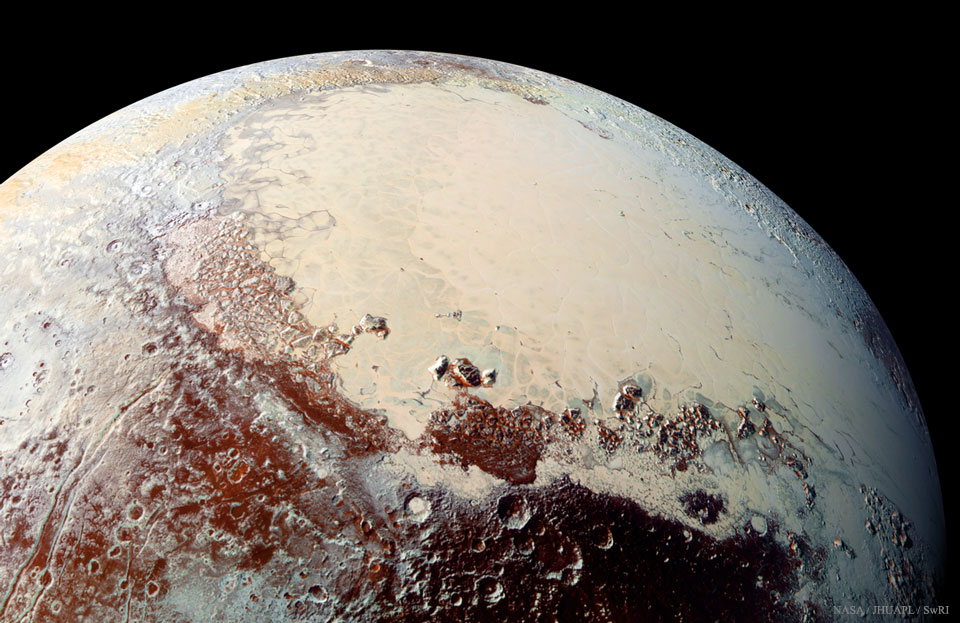
New Horizons Publishes First Research Paper in 'Science,' Describing Numerous Pluto System Findings
http://pluto.jhuapl.edu/Mission/index.php
http://adsabs.harvard.edu/abs/2016GeoRL..4310068J
http://phys.org/news/2016-09-pluto-heart-ocean.html
https://apod.nasa.gov/apod/image/1508/PlutoEnhanced_NewHorizons_1920.jpg

- Code:
Explanation: Is there an ocean below Sputnik Planum on Pluto? The unusually smooth 1000-km wide golden expanse, visible in the from New Horizons, appears segmented into convection cells. But how was this region created? One hypothesis now holds the answer to be a great impact that stirred up an underground ocean of salt water roughly 100-kilometers thick. The featured image of Sputnik Planum, part of the larger heart-shaped Tombaugh Regio, was taken last July and shows true details in exaggerated colors. Although the robotic New Horizons spacecraft is off on a new adventure, continued computer-modeling of this surprising surface feature on Pluto is likely to lead to more refined speculations about what lies beneath.
New Horizons Publishes First Research Paper in 'Science,' Describing Numerous Pluto System Findings
http://pluto.jhuapl.edu/Mission/index.php
http://adsabs.harvard.edu/abs/2016GeoRL..4310068J
http://phys.org/news/2016-09-pluto-heart-ocean.html
https://apod.nasa.gov/apod/image/1508/PlutoEnhanced_NewHorizons_1920.jpg
 Manhattan GandhiLeveL V
Manhattan GandhiLeveL V
- Posts : 565
Join date : 2016-01-09
Age : 47
Location : R'Lyeh
 Four Planets Orbiting Star HR 8799
Four Planets Orbiting Star HR 8799
Wed Feb 01, 2017 8:01 pm
Four Planets Orbiting Star HR 8799
https://www.youtube.com/watch?time_continue=1&v=Zg9Y4g4e1mU
https://www.youtube.com/watch?v=86ol9--ja_8
The images for the video were taken over seven years from the Keck Observatory in Hawaii.
Four exoplanets appear as white dots partially circling their parent star, purposefully occluded
in the center. The central star HR 8799 is slightly larger and more massive than our Sun, while
each of the planets is thought to be a few times the mass of Jupiter. The HR 8799 system lies
about 130 light years away toward the constellation of Pegasus.
https://www.youtube.com/watch?time_continue=1&v=Zg9Y4g4e1mU
https://www.youtube.com/watch?v=86ol9--ja_8
The images for the video were taken over seven years from the Keck Observatory in Hawaii.
Four exoplanets appear as white dots partially circling their parent star, purposefully occluded
in the center. The central star HR 8799 is slightly larger and more massive than our Sun, while
each of the planets is thought to be a few times the mass of Jupiter. The HR 8799 system lies
about 130 light years away toward the constellation of Pegasus.
 The Mysterious Rings of Supernova 1987A
The Mysterious Rings of Supernova 1987A
Sun Mar 05, 2017 5:33 pm
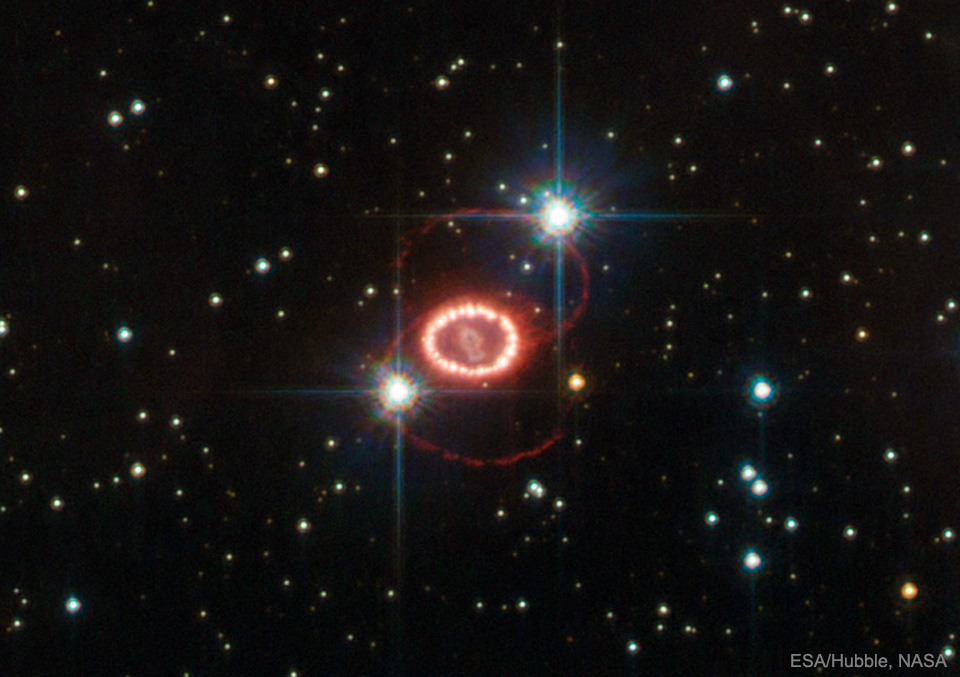
http://www.spacetelescope.org/images/potw1142a/
Dominating this picture are two glowing loops of stellar material and a very bright ring surrounding
the dying star at the centre of the frame. Although Hubble has provided important clues on the
nature of these structures, their origin is still largely unknown.
The supernova belongs to the Large Magellanic Cloud, a nearby galaxy about 168 000 light-years away.
Even though the stellar explosion took place around 166 000 BC, its light arrived here less than 25 years ago.
This picture is based on observations done with the High Resolution Channel of Hubble’s Advanced Camera for
Surveys. The field of view is approximately 25 by 25 arcseconds.
https://arxiv.org/abs/1008.3387
 Manhattan GandhiLeveL V
Manhattan GandhiLeveL V
- Posts : 565
Join date : 2016-01-09
Age : 47
Location : R'Lyeh
 Approaching the NGC 7635
Approaching the NGC 7635
Sat May 27, 2017 5:00 pm
Approaching the NGC 7635
NGC 7635 is a H II region emission nebula in the constellation Cassiopeia created by
the stellar wind from a massive hot, 8.7 magnitude young central star, SAO 20575
(BD+60°2522) . It was discovered in 1787 by William Herschel.
http://www.star.ucl.ac.uk/~apod/apod/ap160422.html
wikisky : DSS2
 Big picture
Big picture Manhattan GandhiLeveL V
Manhattan GandhiLeveL V
- Posts : 565
Join date : 2016-01-09
Age : 47
Location : R'Lyeh
 Saturn
Saturn
Fri Sep 15, 2017 2:00 am
 https://saturn.jpl.nasa.gov/
https://saturn.jpl.nasa.gov/On Sept. 15, 2017, the spacecraft will make its final approach to the giant planet Saturn. Cassini will dive into the planet’s atmosphere, sending science data for as long as its small thrusters can keep the spacecraft’s antenna pointed at Earth. Soon after, Cassini will burn up and disintegrate like a meteor.
Launched on Oct. 15, 1997, the mission entered orbit around Saturn on June 30, 2004 (PDT), carrying the European Huygens probe. After its four-year prime mission, Cassini’s tour was extended twice. Its key discoveries have included the global ocean with indications of hydrothermal activity within Enceladus, and liquid methane seas on Titan.
"The spacecraft's final signal will be like an echo. It will radiate across the solar system for nearly an hour and a half after Cassini itself has gone."
5.6k Saturn Cassini Photographic Animation
 C/2020 F3 NEOWISE
C/2020 F3 NEOWISE
Wed Jul 15, 2020 4:00 pm
 C/2020 F3 {NEOWISE}
C/2020 F3 {NEOWISE} TheSkyLive
TheSkyLive Friday, April 3, 2020 New Comet C/2020 F3 / E.Guido
Friday, April 3, 2020 New Comet C/2020 F3 / E.Guido Star Finder Chart - July 2020
Star Finder Chart - July 2020---------------------------------------------------

---------------------------------------------------
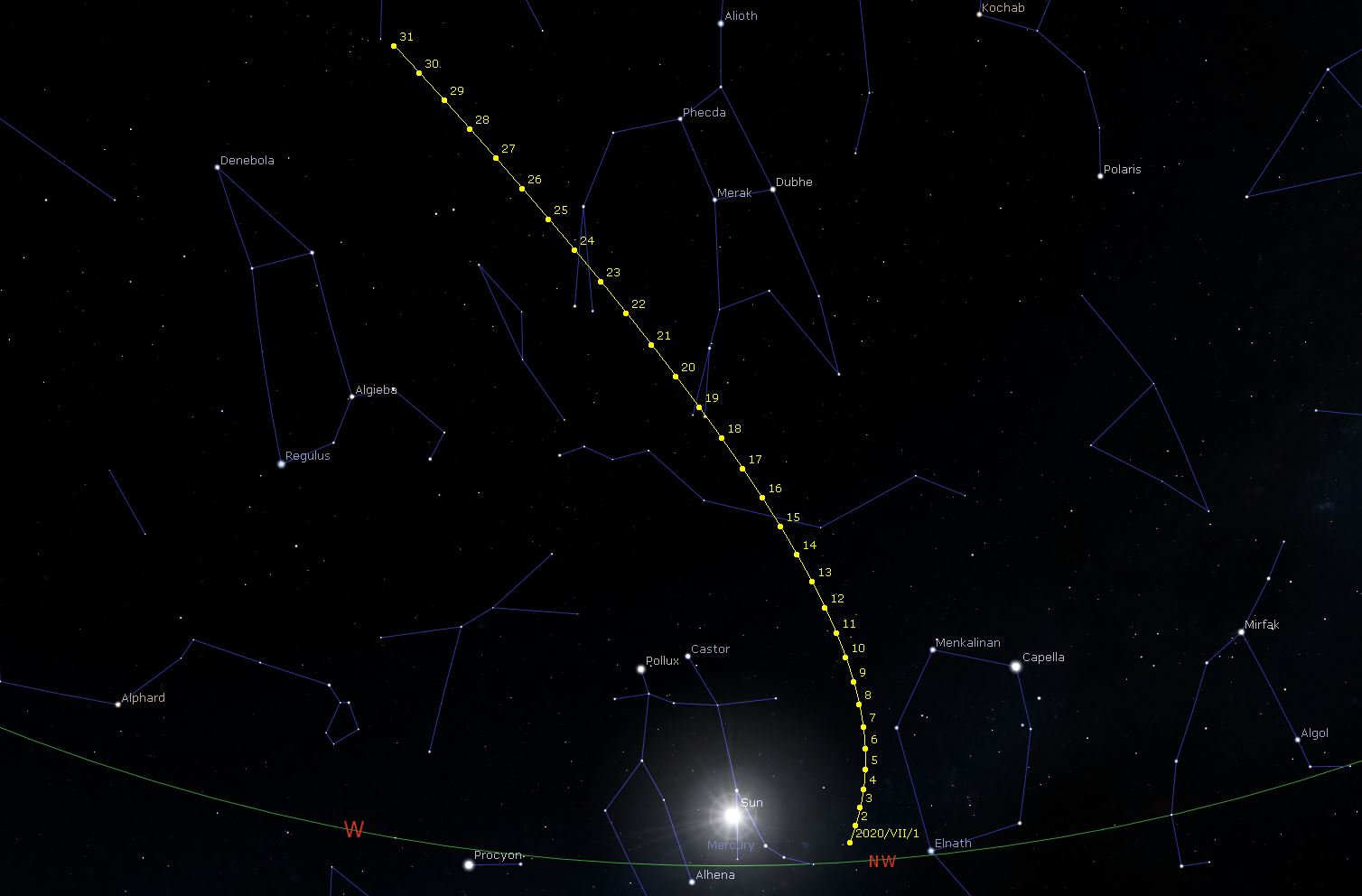
 The Cheshire Cat Gravitational Lens
The Cheshire Cat Gravitational Lens
Mon Jul 20, 2020 1:00 am
https://chandra.harvard.edu/photo/2015/cheshirecat/
Albert Einstein's general theory of relativity, - 100 years ago - , predicted the phenomenon of gravitational lensing. And that's what gives these distant galaxies such a whimsical appearance, seen through the looking glass of X-ray and optical image data from the Chandra and Hubble space telescopes. Nicknamed the Cheshire Cat galaxy group, the group's two large elliptical galaxies are suggestively framed by arcs. The arcs are optical images of distant background galaxies lensed by the foreground group's total distribution of gravitational mass. Of course, that gravitational mass is dominated by dark matter. The two large elliptical "eye" galaxies represent the brightest members of their own galaxy groups which are merging. Their relative collisional speed of nearly 1,350 kilometers/second heats gas to millions of degrees producing the X-ray glow shown in purple hues. Curiouser about galaxy group mergers? The Cheshire Cat group grins in the constellation Ursa Major, some 4.6 billion light-years away.
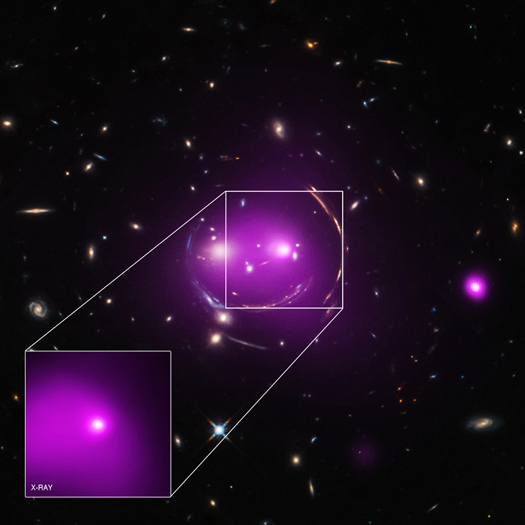

https://arxiv.org/abs/1505.05501
 The Project Gutenberg eBook of Alice’s Adventures in Wonderland, by Lewis Carroll
The Project Gutenberg eBook of Alice’s Adventures in Wonderland, by Lewis Carroll
Albert Einstein's general theory of relativity, - 100 years ago - , predicted the phenomenon of gravitational lensing. And that's what gives these distant galaxies such a whimsical appearance, seen through the looking glass of X-ray and optical image data from the Chandra and Hubble space telescopes. Nicknamed the Cheshire Cat galaxy group, the group's two large elliptical galaxies are suggestively framed by arcs. The arcs are optical images of distant background galaxies lensed by the foreground group's total distribution of gravitational mass. Of course, that gravitational mass is dominated by dark matter. The two large elliptical "eye" galaxies represent the brightest members of their own galaxy groups which are merging. Their relative collisional speed of nearly 1,350 kilometers/second heats gas to millions of degrees producing the X-ray glow shown in purple hues. Curiouser about galaxy group mergers? The Cheshire Cat group grins in the constellation Ursa Major, some 4.6 billion light-years away.


https://arxiv.org/abs/1505.05501
 The Project Gutenberg eBook of Alice’s Adventures in Wonderland, by Lewis Carroll
The Project Gutenberg eBook of Alice’s Adventures in Wonderland, by Lewis CarrollPermissions in this forum:
You can reply to topics in this forum|
|
|

 Home
Home PortaL
PortaL


 Library
Library
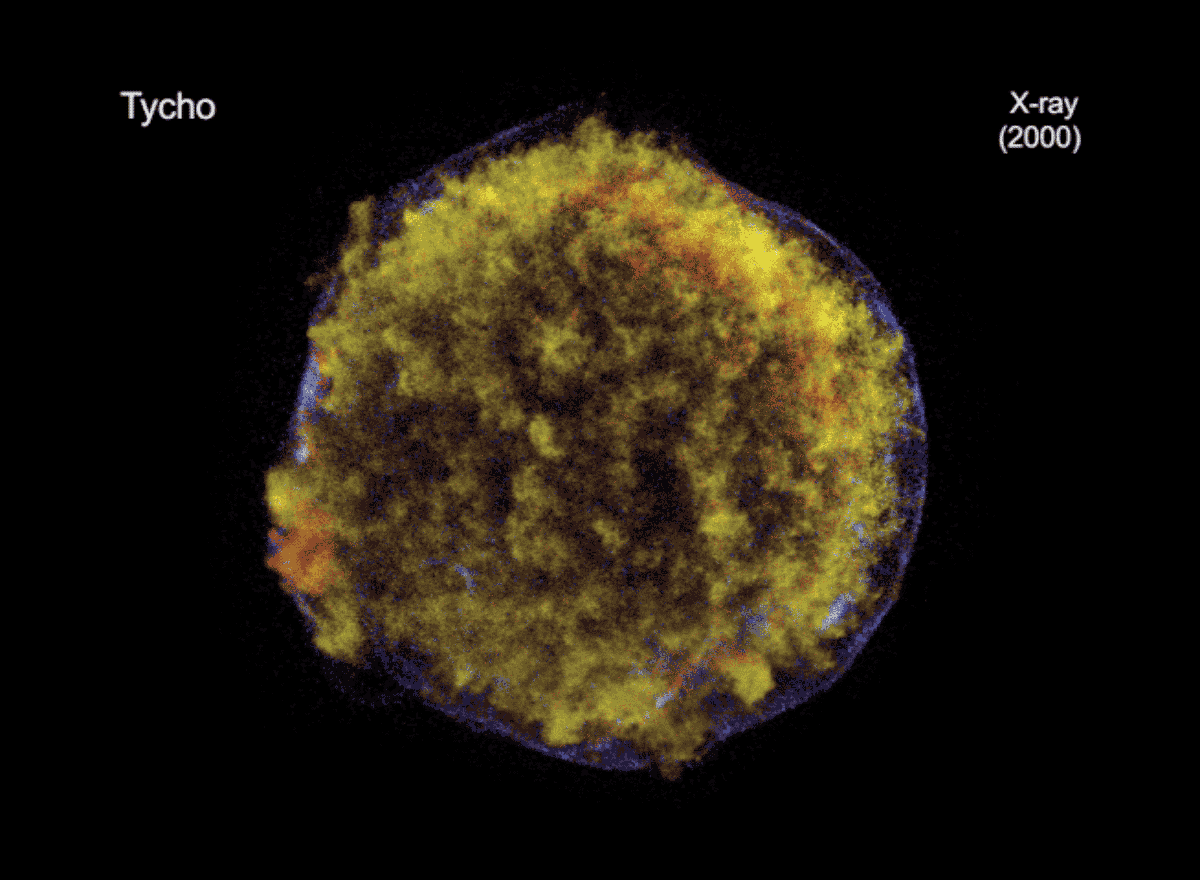
 ]
]